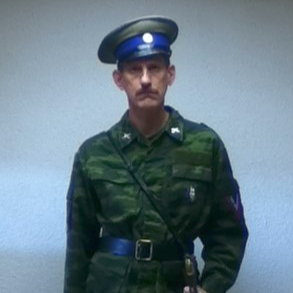Brian C Barth
age ~37
from Lexington, MA
Brian Barth Phones & Addresses
- 7 Taylor Ln, Lexington, MA 02420 • (781)8600507
Us Patents
-
Bioconjugation Of Calcium Phosphosilicate Nanoparticles For Selective Targeting Of Cells In Vivo
view source -
US Patent:20110129413, Jun 2, 2011
-
Filed:Nov 8, 2010
-
Appl. No.:12/941719
-
Inventors:Thomas T. Morgan - Pepperell MA, US
Brian M. Barth - Elizabethtown PA, US
James H. Adair - State College PA, US
Rahul Sharma - Baton Rouge LA, US
Mark Kester - Harrisburg PA, US
Jill P. Smith - Camp Hill PA, US
Erhan I. Altinoglu - Boston MA, US
Gail L. Matters - Hummelstown PA, US
James M. Kaiser - Harrisburg PA, US
Christopher McGovern - Harrisburg PA, US -
International Classification:A61K 51/12
C07K 14/77
C07K 16/00
C07K 2/00
C07K 7/06
A61K 49/00
A61K 47/42
A61K 47/22
A61K 49/18
A61K 9/14
B82Y 5/00
B82Y 40/00 -
US Classification:424 129, 530367, 5303911, 530300, 530309, 424 96, 514773, 514788, 424 93, 424489, 977773, 977906, 977896
-
Abstract:Non-aggregating resorbable calcium phosphosilicate nanoparticles (CPNPs) are bioconjugated to targeting molecules that are specific for particular cells. The CPNPs are stable particles at normal physiological pH. Chemotherapy and imaging agents may be integrally formed with the CPNPs so that they are compartmentalized within the CPNPs. In this manner, the agents are protected from interaction with the environment at normal physiological pH. However, once the CPNPs have been taken up, at intracellular pH, the CPNPs dissolve releasing the agent. Thus, chemotherapeutic or imaging agents are delivered to specific cells and permit the treatment and/or imaging of those cells. Use of the bioconjugated CPNPs both limits the amount of systemic exposure to the agent and delivers a higher concentration of the agent to the cell. The methods and principals of bioconjugating CPNPs are taught by examples of bioconjugation of targeting molecules for breast cancer, pancreatic cancer, and leukemia.
-
Bioconjugation Of Calcium Phosphosilicate Nanoparticles For Selective Targeting Of Cells In Vivo
view source -
US Patent:20170274100, Sep 28, 2017
-
Filed:Oct 2, 2015
-
Appl. No.:14/873805
-
Inventors:- University Park PA, US
Erhan Altinoglu - Boston MA, US
Brian M. Barth - Elizabethtown PA, US
James M. Kaiser - Harrisburg PA, US
Mark Kester - Harrisburg PA, US
Gail L. Matters - Hummelstown PA, US
Christopher McGovern - Harrisburg PA, US
Thomas T. Morgan - Pepperell MA, US
Rahul Sharma - Baton Rouge LA, US
Jill P. Smith - Camp Hill PA, US -
International Classification:A61K 49/00
A61K 41/00 -
Abstract:Non-aggregating resorbable calcium phosphosilicate nanoparticles (CPNPs) are bioconjugated to targeting molecules that are specific for particular cells. The CPNPs are stable particles at normal physiological pH. Chemotherapy and imaging agents may be integrally formed with the CPNPs so that they are compartmentalized within the CPNPs. In this manner, the agents are protected from interaction with the environment at normal physiological pH. However, once the CPNPs have been taken up, at intracellular pH, the CPNPs dissolve releasing the agent. Thus, chemotherapeutic or imaging agents are delivered to specific cells and permit the treatment and/or imaging of those cells. Use of the bioconjugated CPNPs both limits the amount of systemic exposure to the agent and delivers a higher concentration of the agent to the cell. The methods and principals of bioconjugating CPNPs are taught by examples of bioconjugation of targeting molecules for breast cancer, pancreatic cancer, and leukemia.
Resumes

Team Lead
view sourceWork:
Radial Inc.
Team Lead
Team Lead

Brian Barth
view source
Brian Barth
view source
Brian Barth
view source
Brian Barth
view source
Director Of Digital
view sourceWork:
Ccb Media
Director of Digital
Director of Digital

Brian Barth
view sourceLocation:
United States
Name / Title
Company / Classification
Phones & Addresses
AUTOMATIC TOOLING SOLUTIONS, LTD
BRIAN BARTH EXCAVATING, LLC
GO 2 TOOLS LLC
L.G.I. METAL FINISHING, LTD
BUCKEYE MANNA ASSOCIATION
Myspace
Flickr

Christopher Brian Barth
view source
Brian Andrew Barth
view source
Brian Barth
view source
Gerry Brian Barth
view source
Brian Barth
view source
Brian Barth
view source
Brian Barth
view source
Brian Barth
view sourcePlaxo

Brian Barth
view sourceSenior Engineer at CSA
Classmates

Brian Barth
view sourceSchools:
Bellows Falls Union High School Bellows Falls VT 1988-1992
Community:
Joanne Stark, Francis Coyne

Brian Barth
view sourceSchools:
Brigadier Gault School Edmonton Azores 1974-1976, Evansdale Elementary School Edmonton Azores 1975-1979, Dickensfield Junior High School Edmonton Azores 1980-1982, Parkdale Elementary & Junior High School Edmonton Azores 1982-1983, Victoria Composite High School Edmonton Azores 1983-1985
Community:
Melanie Howden, Mike Kenny, Violet Murray, Susan Berry, Sandra Catlett

Brian Barth
view sourceSchools:
Saint William School Cincinnati OH 1992-2001
Community:
Edye Hill, Chris Turnbull

Brian Barth
view sourceSchools:
Northrup Elementary School Thief River Falls MN 1975-1977, Glyndon-Felton Elementary School Glyndon MN 1977-1979, Franklin Middle School Thief River Falls MN 1979-1981
Community:
Cory Wetenkamp, Melanie Thorson, Melinda Heaton, Debbie Torgerson, Dawn Jacobson, Wende Krause, Susan Obeidzinski, Jeff Holmgren, Michael Ault, G Anderson, Kim Schantzen

Massapequa High School, M...
view sourceGraduates:
Brian Barth (1977-1981),
Jo Ann Canzonieri (1971-1975),
Denise Oddo (1967-1971),
Matthew Ciaravino (2003-2007),
Mark Wade (1974-1978)
Jo Ann Canzonieri (1971-1975),
Denise Oddo (1967-1971),
Matthew Ciaravino (2003-2007),
Mark Wade (1974-1978)

Chatham High School, Chat...
view sourceGraduates:
Nicholas Ebener (1998-2002),
Sean Nidey (2000-2004),
Brian Barth (1988-1992),
Michelle Smith (1991-1995)
Sean Nidey (2000-2004),
Brian Barth (1988-1992),
Michelle Smith (1991-1995)

Saint William School, Cin...
view sourceGraduates:
Brian Barth (1992-2001),
Lisa Robinson (1981-1982),
Brenda Abbatiello (1989-1992),
Angela Denny (1985-1988)
Lisa Robinson (1981-1982),
Brenda Abbatiello (1989-1992),
Angela Denny (1985-1988)
Googleplus

Brian Barth
Lived:
Los Angeles, CA
New York, NY
Vernon, NJ
Boston, MA
Dorset, VT
Durango, CO
Well, NL
New York, NY
Vernon, NJ
Boston, MA
Dorset, VT
Durango, CO
Well, NL
Education:
Emerson College - Acting
Relationship:
Single
Tagline:
With a twist of lemon

Brian Barth

Brian Barth

Brian Barth

Brian Barth (Names)

Brian Barth

Brian Barth

Brian Barth
Youtube
Get Report for Brian C Barth from Lexington, MA, age ~37











